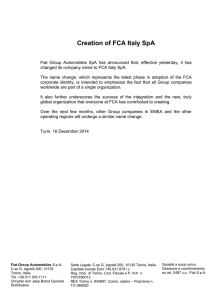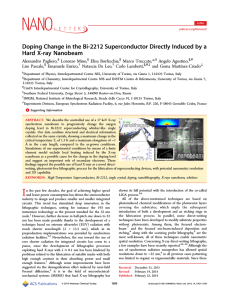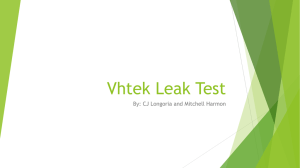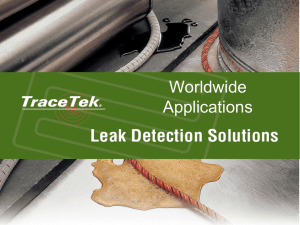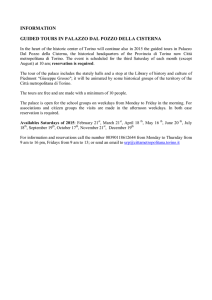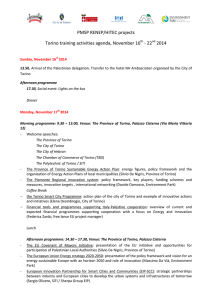Quantitative and qualitative leak testing
advertisement
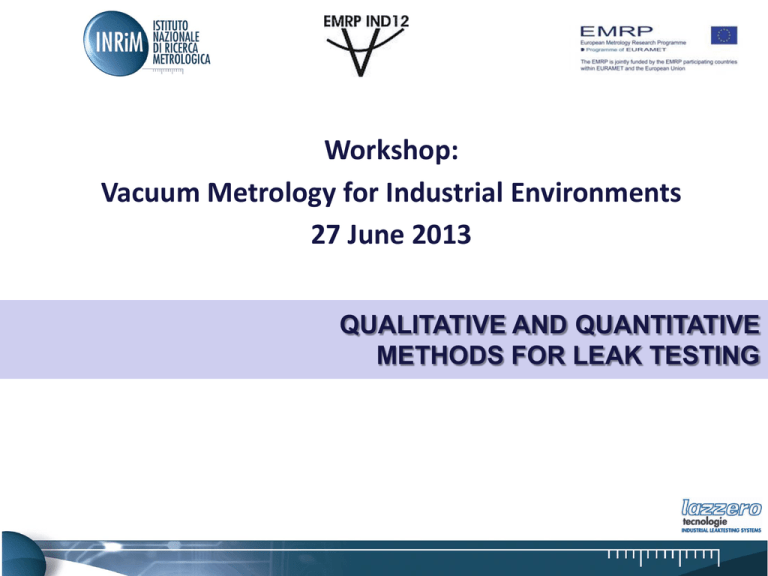
Workshop: Vacuum Metrology for Industrial Environments 27 June 2013 QUALITATIVE AND QUANTITATIVE METHODS FOR LEAK TESTING LEAK TESTING: definition UNI 8450 - February ’83 Non-Destructive Testing • “Examination conducted to verify compliance of materials or components respect to specified requirements, using techniques that do not harm the characteristics or performance." Definition according ASNT Non-Destructive Testing • “Non-destructive testing is to determine the physical conditions of an object avoiding to compromise the functions for which the object was constructed.” Torino, 27 June 2013 2 Leak Testing The leak testing should not be understood as an abstract search of an unrealizable leak from the value of zero. It is an intelligent check within the production process. It is finalized at a non-statistical control, but continuum control of the compliance of products with the requirements of tightness. Torino, 27 June 2013 3 The unit of measurement of gaseous flow: mbar·L/s The fluid flow • is expressed for example in cm3/s or in L/min and more. The gaseous flow • is expressed for example in mbarL/s or in Pam3/s and more. Pressure Varation Volume Time Leakrate in mbar·L/s 1 mbar 1L 1s 1 = 100 1 mbar 0,1 L 10 s 0,01 = 10-2 0,01 mbar 0,1 L 100 s 0,00001 = 10-5 TIGHTNESS mbar·L/s Water tight 10-2 Vapor Tightness 10-3 Oil and Gasoline Tightness 10-4 Bacteria Tightness 10-5 Virus Tightness 10-6 “Absoluta” Tightness (technique) 10-10 Torino, 27 June 2013 4 The Correct Approach The correct approach to the choice of method for the leak testing: 1. 4. Define the requirement of the leak testing 2. Calculate the allowed limits of the leak 3. Choose the suitable method of leak testing Compare the different economic solutions Torino, 27 June 2013 5 Methods for Leak Detection PRESSURE CHANGE METHOD • pressure decay • pressure rise BUBBLE TEST (immersion or covering) • Identified only for the localization of the leaks ULTRASONIC DETECTION • spontaneous • induced LEAK TESTING WITH TRACER GASES • thermal conductivity • mass spectrometry Torino, 27 June 2013 6 Pressurize the piece in test and then check the pressure decay. Reduce the pressure in the piece (by pumping in vacuum) and then check the pressure rise. METHOD 2 METHOD 1 Pressure Change Method absolute pressure transducer The measurements can be carried out with: • direct measurements ΔP, differential pressure transducer • ΔP measured of the piece and a reference volume together and then individually. Torino, 27 June 2013 7 Pressure Change Method A pressurized or evacuated component, of known volume, have to be monitored: Pressure of gas Temperature (internal) of gas Duration of test Case II Case I No or minimal variation of temperature: You do not have significant variations in the volume and therefore of the pressure during the test. From pressure variation (Δp) measured in the time interval (Δt) and known volume (V) of the piece in test, it is possible to calculate the value of gas flow: q = (Δp / Δt) x V Substantial variation of temperature: significant variations in the the pressure during the test. The rate of leak is calculated as following: q = (P1 - (P2 x (T1/T2))x V)/Δt P1 P2 T1 T2 V Δt initial pressure final pressure initial temperature final temperature volume duration of the test Torino, 27 June 2013 8 Pressure Change Method Advantages: • economic system, it is sufficient a pressure gauge for rough measurement; • use of only compressed air; • no "memory" at the end of the test. Disadvantages: • strong dependence of the temperature: the variations during the test could invalidate the measurements; • different volumes in the test pieces, with the same measurement time, affect the results; • measurement of lower flows require longer times. Torino, 27 June 2013 9 Bubble test In the immersion or covering with liquid of a part, the bubbles are formed in the area of the leaks. The bubbles are produced when the internal pressure exceeds the forces of surface tension of the external liquid. The size of the bubbles and the emission frequency depend on: • the type of gas flow, • the size of the leak, • the surface tension of the liquid. Torino, 27 June 2013 10 Bubble test Identified only for the localization of the leak Using liquids with a low surface tension, it is possible to detect flows from 1/50 to 1/100 of the smallest detectable flow using the bubble test in water. Torino, 27 June 2013 11 Bubble Test Application (vacuum) For the localization of leaks on different types of food packaging, from coffee pods to the confectionery products, such as chocolates. Torino, 27 June 2013 12 Ultrasonic Detection The propagation of ultrasound occurs by vibration of molecules in the fluid and from the fluid are absorbed in the inverse function of the density or aggregation state. Ultrasound propagate not much in gas, air and steam, but better in liquid. In vacuum it does not propagate. The directionality of ultrasound is a fundamental characteristic, while the intensity is an inverse function of source-sensor distance. Torino, 27 June 2013 13 Ultrasonic Detection The characteristics of directionality and decay facilitate the localization of the source of the detected wave of ultrasound. The method of ultrasonic detection is divided in : Passive type Active type • when the emissions are spontaneously emitted by the pieces in test, • when controls are carried out with the assistance of ultrasound artificially generated. Torino, 27 June 2013 14 Ultrasonic Detection Advantages: • absence of tracer gases; • use of only compressed air; • no "memory" at the end of the test. Disadvantages: • the commercial devices have a high sensitivity (adjustable) but they do not detect microleaks in the absence of turbulence. It is necessary to use ultrasounds generated artificially; • all the phenomena of mechanical friction, of turbulent motions of fluid moved by the pressure difference emit spontaneously ultrasound. Torino, 27 June 2013 15 for being detected. so to induce the tracer gas to move through possible leaks Tracer Gases submit the particular to be tested to a pressure difference The process of leaktesting with the use of tracer gases considers to Torino, 27 June 2013 16 Tracer Gases:Thermal Conductivity These devices are mostly portable types as probes. The different gases are detected according to their different thermal conductivity. These characteristics varies with dependence from molecular size and speed. They can be used with different gas or gas mixtures, since each of them produces a different thermal conductivity respect to the air. Torino, 27 June 2013 17 Tracer Gases:Thermal Conductivity Through a probe, the gas is conveyed, with a small fan or a small pump, on a hot filament maintained in thermal - energy equilibrium. The variation, although minimum, made by the gas, is used as a signal for the determination of the leak. Torino, 27 June 2013 18 Tracer Gases:Thermal Conductivity Advantages: • low cost; • possibility to operate with different gases; • high maneuverability and transportability. Diasdvantages: • use only in sniffer mode; • difficulty in determination of the leaks in terms of volumetric flow; • gas extraneous to the process can affect the measurements. Torino, 27 June 2013 19 Tracers Gases: Mass Spectrometry Torino, 27 June 2013 20 Tracers Gases: Quartz Capillary In this leak detector, the detection system of the tracer gas (helium) is constituted by a membrane in quartz, permeable only for helium and not other gases present in the atmosphere. Torino, 27 June 2013 21 The tracer gas mostly used is HELIUM because of its chemicalphysical characteristics: is non-toxic, has no taste and no smell, does not pollute, does not disturb the ambient, is chemically and physically inert (is non-combustible and non-oxidizing), is present in atmospheric air in a minimum quantity (5 ppm). Torino, 27 June 2013 22 Symbol: He Atomic number: 2 Atomic mass: 4 From the greek: hêlios (sun) Year of discovery: 1895 Discoverers: Sir William Ramsey, Nils Langet , P.T.Cleve Inert gas, odorless, colorless and tasteless. It is the second most abundant element in the universe and the sixth in the atmosphere. It is located in deposits of natural gas (presence up to 9%) and in air (5.2 x 10-4 in parts). Helium of endogenous origin comes from the decay of radioactive elements present in the subsoil. Used in balloons, in breathing mixtures for deep water, in thermometers, in the leak testing methods. Through the evaporation of liquid He you can reach temperatures of 0.5 K. Torino, 27 June 2013 23 Test Methods with Mass Spectrometry [UNI EN 1779:2004 – B.4] ADVANTAGES • It is the most simple and intuitive method. • Low-cost, you can operate with high Dp, up to the limits of safety. Test System with Probe Sniffer DISADVANTAGES • Requires high attention and experience of the operator. Torino, 27 June 2013 24 Test Methods with Mass Spectrometry Test System by Spraying [UNI EN 1779:2004 – A.3] ADVANTAGES • It is a valid and safe industrial process for quality testing. • It is easy to carry out, and it is useful with great volumes. DISADVANTAGES • The ΔP is limited to 1 bar, high consume of helium gas. Torino, 27 June 2013 25 Test Methods with Mass Spectrometry Integral Test Method [UNI EN 1779:2004 – B.6] ADVANTAGES • It is the most complete and versatile method. • It is allowed to test pieces at high ΔP and the result is the sum of the leaks present. DISADVANTAGES • It does not furnish the localization of the leaks; • High cost. Torino, 27 June 2013 26 It is firstly possible distinguish two different types for the leak testing: A) Leak Detection Methods (QUALITATIVE), generally controlled by operator, with localization of leak: • • • • • Method in Water with pressurized piece (visual inspection); Method with Bubble (soap solution) with pressurized piece (visual inspection); Method with Ultraviolet Lamps with pressurized piece (visual inspection); Method with Hot Air (visual inspection at infrared); Method with Dielectric Variation on plastic components (ionic system at high voltage). Torino, 27 June 2013 27 B) Leak Detection Method (QUANTITATIVE) with indication of Good, Reject Piece and value of leakrate: • • • • • Measurement with presurized gas (Helium); Measurement the flow meter of the pressurized piece; Measurement of the pressure differential between the pressurized piece and the reference sample; Measurement of the pressure decay of the pressurized piece; Measurement “compliance” of pressure increase in vacuum bell. The instrumentation of this type allows you to monitor in time any drifts of quality, if it is applied throughout the production. Torino, 27 June 2013 28 Metrological Laboratory Torino, 27 June 2013 29 Gas Injection System Pumping System LT-SP-1 Pumping System LT-SP-2 Leak in Calibration Pressure Gauge LT-TP-1 Reference Capillary Leak Mass Spectrometer Reference Capillary Leak Scheme of calibration system Reference Capillary Leak Reference Permeation Leak Torino, 27 June 2013 30 The calibration requires a calibrated device: REFERENCE LEAK Torino, 27 June 2013 31 JRP14i – Joint Research Project - Work Packages 2 – Optimization of the process of measurement and leak testing in an industrial environment. Torino, 27 June 2013 32 JRP14i – Joint Research Project - Work Packages 2 – Optimization of the process of measurement and leak testing in an industrial environment. Study and analysis of the main parameters of the leak detector for refrigerants. Manufacturing of Capillary Leak with Gas Refrigerants (respect to atmosphere). Study of the behavior of the flow of Gas Refrigerants through capillary leaks. Torino, 27 June 2013 33
